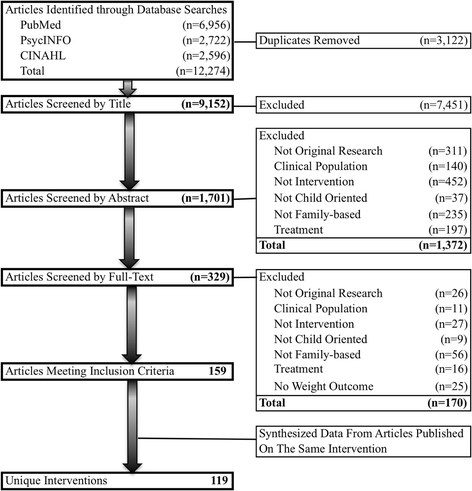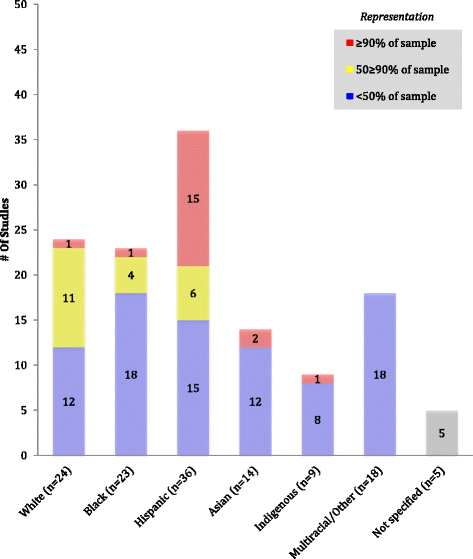Family-based childhood obesity prevention interventions: a systematic review and quantitative content analysis
- PMID: 28836983
- PMCID: PMC5571569
- DOI: 10.1186/s12966-017-0571-2
Family-based childhood obesity prevention interventions: a systematic review and quantitative content analysis
Abstract
Background: A wide range of interventions has been implemented and tested to prevent obesity in children. Given parents' influence and control over children's energy-balance behaviors, including diet, physical activity, media use, and sleep, family interventions are a key strategy in this effort. The objective of this study was to profile the field of recent family-based childhood obesity prevention interventions by employing systematic review and quantitative content analysis methods to identify gaps in the knowledge base.
Methods: Using a comprehensive search strategy, we searched the PubMed, PsycIFO, and CINAHL databases to identify eligible interventions aimed at preventing childhood obesity with an active family component published between 2008 and 2015. Characteristics of study design, behavioral domains targeted, and sample demographics were extracted from eligible articles using a comprehensive codebook.
Results: More than 90% of the 119 eligible interventions were based in the United States, Europe, or Australia. Most interventions targeted children 2-5 years of age (43%) or 6-10 years of age (35%), with few studies targeting the prenatal period (8%) or children 14-17 years of age (7%). The home (28%), primary health care (27%), and community (33%) were the most common intervention settings. Diet (90%) and physical activity (82%) were more frequently targeted in interventions than media use (55%) and sleep (20%). Only 16% of interventions targeted all four behavioral domains. In addition to studies in developing countries, racial minorities and non-traditional families were also underrepresented. Hispanic/Latino and families of low socioeconomic status were highly represented.
Conclusions: The limited number of interventions targeting diverse populations and obesity risk behaviors beyond diet and physical activity inhibit the development of comprehensive, tailored interventions. To ensure a broad evidence base, more interventions implemented in developing countries and targeting racial minorities, children at both ends of the age spectrum, and media and sleep behaviors would be beneficial. This study can help inform future decision-making around the design and funding of family-based interventions to prevent childhood obesity.
Keywords: Childhood obesity; Diet; Family-based; Media use; Physical activity; Sedentary behavior; Sleep.
Conflict of interest statement
Ethics approval and consent to participate
Not applicable
Consent for publication
Not applicable
Competing interests
The authors declare that they have no competing interests.
Publisher’s Note
Springer Nature remains neutral with regard to jurisdictional claims in published maps and institutional affiliations.
Figures
References
-
- Ng M, Fleming T, Robinson M, Thomas B, Graetz N, Margono C, et al. Global, regional, and national prevalence of overweight and obesity in children and adults during 1980-2013: a systematic analysis for the global burden of disease study 2013. Lancet. 2014;384(9945):766–781. doi: 10.1016/S0140-6736(14)60460-8. - DOI - PMC - PubMed
Publication types
MeSH terms
LinkOut - more resources
Full Text Sources
Other Literature Sources
Medical



